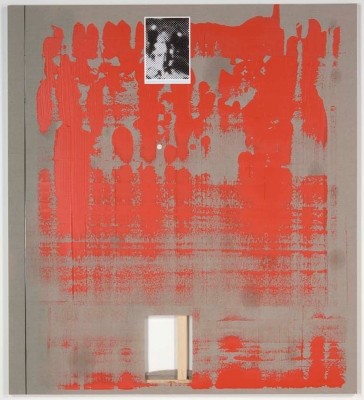Michael Wilkinson
01 Jun - 07 Jul 2012

© Michael Wilkinson
'Seditionaries' No. 2, 2010
Acrylic on linen with verdigris, oil, beeswax, digital print, graphite pencil, audio tape, two painted badges
74 3/4 x 67 x 1 3/8 inches (190 x 170 x 3.5 centimeters)
'Seditionaries' No. 2, 2010
Acrylic on linen with verdigris, oil, beeswax, digital print, graphite pencil, audio tape, two painted badges
74 3/4 x 67 x 1 3/8 inches (190 x 170 x 3.5 centimeters)
MICHAEL WILKINSON
No History
1 June – 7 July 2012
“History is made by those that say ‘No’ and Punk’s utopian heresies remain its gift to the world.” (Jon Savage, England’s Dreaming: Sex Pistols and Punk Rock)
Blum & Poe is very pleased to present Michael Wilkinson’s No History, marking his solo debut at the gallery. Culling references from art history, punk rock, popular culture, and anarchism, Wilkinson creates subtly layered canvases and sculptures. For this exhibition, he has created a series of twelve red abstract paintings featuring images of the May 1968 Paris riots, which began with student protests and progressed to a general workers’ strike, bringing the entire nation to a standstill. The series is organized around a sequence of images taken from the introduction of Gordon Carr's book The Angry Brigade and is embellished with pages depicting aspects of the conflict from a Paris Match of the period. This red wall of canvases are interlocked in a continuum, effectively creating a classical frieze commemorating a battle.
A series of etched mirrors titled Dresden, part of which is also on view in the exhibition, focuses on the Allied bombing of the city at the end of World War II, a firestorm which controversially decimated a place known more as a cultural landmark than as an industrial center and killed tens of thousands of civilians. Punk impresario Malcolm McLaren and his then girlfriend Vivienne Westwood displayed images of the ruins of Dresden as wallpaper in their London shop Seditionaries. Wilkinson wanted to incorporate these same images into his works, but was unable to locate the originals. Instead, he substituted details from an image taken in 1944 of a bombed out Liverpool, extending Dresden as a metaphor for the ravages wrought upon his home city during his lifetime.
Wilkinson employs a sophisticated collage technique that reflects his multiple subject references and includes as many disparate materials: acrylic, beeswax, oil, string, digital prints, cellophane, audio-tape, Legos, and etched mirrors. His apparently simple layering of elements and monochromatic color palate coalesce the varied subjects and media to enhance his use of historical motifs. Part canvas, part mirror, and part blackboard, these structures evoke the set of influences that converged on popular culture during punk, holding up their heresies as a measure of the present.
Michael Wilkinson was born in Merseyside, UK in 1965 and currently lives and works in Glasgow, Scotland. His group exhibitions include Rubble Stir, Glue Factory, Glasgow; All That Is Solid Melts Into Air, FRAC des Pays de la Loire, Carquefou; Transmission, Kunstverein Graz, Austria; and Wight Biennale, Wight Gallery, University of California, Los Angeles. Blackdog Publishing recently published his book Michael Wilkinson: 1979.
No History
1 June – 7 July 2012
“History is made by those that say ‘No’ and Punk’s utopian heresies remain its gift to the world.” (Jon Savage, England’s Dreaming: Sex Pistols and Punk Rock)
Blum & Poe is very pleased to present Michael Wilkinson’s No History, marking his solo debut at the gallery. Culling references from art history, punk rock, popular culture, and anarchism, Wilkinson creates subtly layered canvases and sculptures. For this exhibition, he has created a series of twelve red abstract paintings featuring images of the May 1968 Paris riots, which began with student protests and progressed to a general workers’ strike, bringing the entire nation to a standstill. The series is organized around a sequence of images taken from the introduction of Gordon Carr's book The Angry Brigade and is embellished with pages depicting aspects of the conflict from a Paris Match of the period. This red wall of canvases are interlocked in a continuum, effectively creating a classical frieze commemorating a battle.
A series of etched mirrors titled Dresden, part of which is also on view in the exhibition, focuses on the Allied bombing of the city at the end of World War II, a firestorm which controversially decimated a place known more as a cultural landmark than as an industrial center and killed tens of thousands of civilians. Punk impresario Malcolm McLaren and his then girlfriend Vivienne Westwood displayed images of the ruins of Dresden as wallpaper in their London shop Seditionaries. Wilkinson wanted to incorporate these same images into his works, but was unable to locate the originals. Instead, he substituted details from an image taken in 1944 of a bombed out Liverpool, extending Dresden as a metaphor for the ravages wrought upon his home city during his lifetime.
Wilkinson employs a sophisticated collage technique that reflects his multiple subject references and includes as many disparate materials: acrylic, beeswax, oil, string, digital prints, cellophane, audio-tape, Legos, and etched mirrors. His apparently simple layering of elements and monochromatic color palate coalesce the varied subjects and media to enhance his use of historical motifs. Part canvas, part mirror, and part blackboard, these structures evoke the set of influences that converged on popular culture during punk, holding up their heresies as a measure of the present.
Michael Wilkinson was born in Merseyside, UK in 1965 and currently lives and works in Glasgow, Scotland. His group exhibitions include Rubble Stir, Glue Factory, Glasgow; All That Is Solid Melts Into Air, FRAC des Pays de la Loire, Carquefou; Transmission, Kunstverein Graz, Austria; and Wight Biennale, Wight Gallery, University of California, Los Angeles. Blackdog Publishing recently published his book Michael Wilkinson: 1979.
